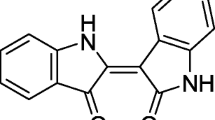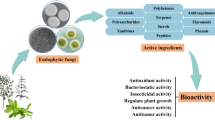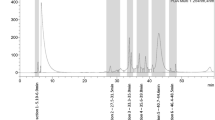Abstract
α-Tomatine, isolated from Lycopersicon esculentum Linn., is a naturally occurring glycoalkaloids in immature green tomatoes. Some reports demonstrated that α-tomatine had various anti-carcinogenic properties. First, the result demonstrated α-tomatine could inhibit TPA-induced the abilities of the adhesion, morphology/actin cytoskeleton arrangement, invasion, and migration by cell–matrix adhesion assay, immunofluorescence stain assay, Boyden chamber invasion assay, and wound-healing assay. Data also showed α-tomatine could inhibit the activation of extracellular signal-regulated kinase 1 and 2 (ERK1/2) and protein kinase C-α (PKCα) involved in the downregulation of the enzyme activities and messenger RNA levels of matrix metalloproteinase-2/9 (MMP-2/MMP-9) induced by TPA. Next, α-tomatine also strongly inhibited TPA-induced the activation of nuclear factor kappa B (NF-κB) and phospho-inhibitor of kappa Bα (phospho-IκBα). In addition, TPA-induced translocation of PKC-α from cytosol to membranes, and suppression of TPA elicited the expression of PKC-α by adding the PKC-α inhibitors, GF-109203X and Gö-6983. The treatment of specific inhibitor for ERK (U0126) to MCF-7 cells could inhibit TPA-induced MMP-2/MMP-9 and phospho-ERK along with an inhibition on cell invasion and migration. Application of α-tomatine to prevent the invasion/migration of MCF-7 cells through blocking PKCα/ERK/NF-κB activation is first demonstrated herein.







Similar content being viewed by others
Abbreviations
- TPA:
-
12-O-Tetradecanoylphorbol-13-acetate
- MMPs:
-
Matrix metalloproteinases
- ECM:
-
Extracellular matrix
- PKCα:
-
Protein kinase C-α
- ERK:
-
Extracellular signaling-regulating kinase
- JNK/SAPK:
-
c-Jun N-terminal kinase/stress-activated protein kinase
- p38 MAPK:
-
p38 Mitogen-activated protein kinase
- PI3KAkt:
-
Phosphoinositide 3-kinase/protein kinase B
- NF-κB:
-
Nuclear factor kappa B
- IκBα:
-
Inhibitor of NF-κB
References
Jemal, A., Siegel, R., Ward, E., Murray, T., Xu, J., & Thun, M. J. (2007). Cancer statistics. CA: A Cancer Journal for Clinicians, 57, 43–66.
Bange, J., Zwick, E., & Ullrich, A. (2001). Molecular targets for breast cancer therapy and prevention. Nature Medicine, 7, 548–552.
Roy, A. M., Baliga, M. S., & Katiyar, S. K. (2005). Epigallocatechin-3-gallate induces apoptosis in estrogen receptor-negative human breast carcinoma cells via modulation in protein expression of p53 and Bax and caspase-3 activation. Molecular Cancer Therapeutics, 4, 81–90.
Friedman, M., & Levin, C. E. (1995). α-Tomatine content in tomato and tomato products determined by HPLC with pulsed amperometric detection. Journal of Agriculture and Food Chemistry, 43, 1507–1511.
Lee, K. R., Kozukue, N., Han, J. S., Park, J. H., Chang, E. Y., Baek, E. J., et al. (2004). Glycoalkaloids and metabolites inhibit the growth of human colon (HT29) and liver (HepG2) cancer cells. Journal of Agriculture and Food Chemistry, 52, 2832–2839.
Clemens, M. J., Trayner, I., & Menaya, J. (1992). The role of protein kinase C isoenzymes in the regulation of cell proliferation and differentiation. Journal of Cell Science, 103, 881–887.
Hug, H., & Sarre, T. F. (2005). Protein kinase C isoenzymes: divergence in signal transduction? The Biochemical Journal, 291, 329–343.
Blobe, G. C., Obeid, L. M., & Hannun, Y. A. (1994). Regulation of protein kinase C and role in cancer biology. Cancer and Metastasis Reviews, 13, 411–431.
Tanaka, Y., Gavrielides, M. V., Mitsuuchi, Y., Fujii, T., & Kazanietz, M. G. (2003). Protein kinase C promotes apoptosis in LNCaP prostate cancer cells through activation of p38 MAPK and inhibition of the Akt survival pathway. The Journal of Biological Chemistry, 278, 33753–33762.
Ways, D. K., Kukoly, C. A., deVente, J., Hooker, J. L., Bryant, W. O., Posekany, K. J., et al. (1995). MCF-7 breast cancer cells transfected with protein kinase C-alpha exhibit altered expression of other protein kinase C isoforms and display a more aggressive neoplastic phenotype. The Journal of Clinical Investigation, 95, 1906–1915.
Shimao, Y., Nabeshima, K., Inoue, T., & Koono, M. (1999). TPA-enhanced motility and invasion in a highly metastatic variant (L-10) of human rectal adenocarcinoma cell line RCM-1: selective role of PKC-alpha and its inhibition by a combination of PDBu-induced PKC downregulation and antisense oligonucleotides treatment. Clinical & Experimental Metastasis, 17, 351–360.
Dennis, J. U., Dean, N. M., Bennett, C. F., Griffith, J. W., Lang, C. M., & Welch, D. R. (1998). Human melanoma metastasis is inhibited following ex vivo treatment with an antisense oligonucleotide to protein kinase C-α. Cancer Letters, 128, 65–70.
Jiang, X. H., Tu, S. P., Cui, J. T., Lin, M. C. M., Xia, H. H. X., Wong, W. M., et al. (2004). Antisense targeting protein kinase C α and b1 inhibits gastric carcinogenesis. Cancer Research, 64, 5787–5794.
Wang, S., Konorev, E. A., Kotamraju, S., Joseph, J., Kalivendi, S., & Kalyanaraman, B. (2004). Doxorubicin induces apoptosis in normal and tumor cells via distinctly different mechanisms: intermediacy of H2O2- and p53-dependent pathways. The Journal of Biological Chemistry, 279, 25535–25543.
Chen, Y. C., Shen, S. C., & Tsai, S. H. (2005). Prostaglandin D(2) and J(2) induce apoptosis in human leukemia cells via activation of the caspase 3 cascade and production of reactive oxygen species. Biochimica et Biophysica Acta, 1743, 291–304.
Jang, B. C., Park, Y. K., Choi, I. H., Kim, S. P., Hwang, J. B., Baek, W. K., et al. (2007). 12-O-Tetradecanoyl phorbol 13-acetate induces the expression of B7-DC, -H1, -H2, and -H3 in K562 cells. International Journal of Oncology, 31, 1439–1447.
Carpenter, C. L., & Cantley, L. C. (1996). Phosphoinositide kinases. Current Opinion in Cell Biology, 8, 153–158.
Chung, T. W., Lee, Y. C., & Kim, C. H. (2004). Hepatitis B viral HBx induces matrix metalloproteinase-9 gene expression through activation of ERK and PI-3K/AKT pathways: involvement of invasive potential. The FASEB Journal, 18, 1123–1125.
Chen, P. N., Hsieh, Y. S., Chiou, H. L., & Chu, S. C. (2005). Silibinin inhibits cell invasion through inactivation of both PI3K -Akt and MAPK signaling pathways. Chemico-Biological Interactions, 156, 141–150.
Kwon, G. T., Cho, H. J., Chung, W. Y., Park, K. K., Moon, A., & Park, J. H. (2009). Isoli-quiritigenin inhibits migration and invasion of prostate cancer cells: possible mediation by decreased JNK/AP-1 signaling. The Journal of Nutritional Biochemistry, 20, 663–676.
Lee, S. J., Park, S. S., Lee, U. S., Kim, W. J., & Moon, S. K. (2008). Signaling pathway for TNF-alpha-induced MMP-9 expression: Mediation through p38 MAP kinase, and inhibition by anti-cancer molecule magnolol in human urinary bladder cancer 5637 cells. International Immunopharmacology, 8, 1821–1826.
Mosmann, T. (1983). Rapid colorimetric assay for cellular growth and 1 survival: application to proliferation and cytotoxicity assays. Journal of Immunological Methods, 65, 55–63.
Ochi, Y., Atsumi, S., Aoyagi, T., & Umezawa, K. (1993). Inhibition of tumor cell invasion in the Boyden chamber assay by a mannosidase inhibitor, mannostatin A. Anticancer Research, 13, 1421–1424.
Chu, S. C., Chiou, H. L., Chen, P. N., Yang, S. F., & Hsieh, Y. S. (2004). Silibinin inhibits the invasion of human lung cancer cells via decreased productions of urokinase-plasminogen activator and matrix metalloproteinase-2. Molecular Carcinogenesis, 40, 143–149.
Hoppe-Seyler, F., Butz, K., Rittmuller, C., & von Knebel Doeberitz, M. (1991). A rapid microscale procedure for the simultaneous preparation of cytoplasmic RNA, nuclear DNA binding proteins and enzymatically active luciferase extracts. Nucleic Acids Research, 19, 5080.
Ma, W., Lim, W., Gee, K., Aucoin, S., Nandan, D., Kozlowski, M., et al. (2001). The p38 mitogen-activated kinase pathway regulates the human interleukin-10 promoter via the activation of Sp1 transcription factor in lipopolysaccharide stimulated human macrophages. The Journal of Biological Chemistry, 276, 13664–13674.
Huang, Q., Shen, H. M., & Ong, C. N. (2004). Inhibitory effect of emodin on tumor invasion through suppression of activator protein-1 and nuclear factor-kappaB. Biochemical Pharmacology, 68, 361–371.
Nishizuka, Y. (1992). Intracellular signaling by hydrolysis of phospholipids and activation of PKC. Science, 258, 607–614.
Mellor, H., & Parker, P. J. (1998). The extended protein kinase C superfamily. The Biochemical Journal, 332, 281–292.
Loegering, D. J., & Lennartz, M. R. (2011). Protein kinase C and toll-like receptor signaling. Enzyme Research. Article ID 537821.
Huang, C., Schmid, P. C., Ma, W. Y., Schmid, H. H., & Dong, Z. (1997). Phosphatidylinositol-3 kinase is necessary for 12-O-tetradecanoylphorbol-13-acetate-induced cell transformation and activated protein 1 activation. The Journal of Biological Chemistry, 272, 4187–4194.
Gschwendt, M., Kittstein, W., & Marks, F. (1991). Protein kinase C activation by phorbol esters: do cysteine-rich regions and pseudosubstrate motifs play a role? Trends in Biochemical Sciences, 16, 167–169.
Divecha, N., & Irvine, R. F. (1995). Phospholipid signaling. Cell, 80, 269–278.
Burns, D. J., & Bell, R. M. (1991). Protein kinase C contains two phorbol ester binding domains. The Journal of Biological Chemistry, 266, 18330–18338.
Karin, M., & Ben-Neriah, Y. (2000). Phosphorylation meets ubiquitination: the control of NF-[kappa]B activity. Annual Review of Immunology, 18, 621–663.
Kunnumakkara, A. B., Anand, P., & Aggarwal, B. B. (2008). Curcumin inhibits proliferation, invasion, angiogenesis and metastasis of different cancers through interaction with multiple cell signaling proteins. Cancer Letters, 269, 199–225.
Mercer, B. A., Kolesnikova, N., Sonett, J., & D’Armiento, J. (2004). Extracellular regulated kinase/mitogen activated protein kinase is up-regulated in pulmonary emphysema and mediates matrix metalloproteinase-1 induction by cigarette smoke. The Journal of Biological Chemistry, 279, 17690–17696.
Ning, W., Dong, Y., Sun, J., Li, C., Matthay, M. A., Feghali-Bostwick, C. A., et al. (2007). Cigarette smoke stimulates matrix metalloproteinase-2 activity via EGR-1 in human lung fibroblasts. American Journal of Respiratory Cell and Molecular Biology, 36, 480–490.
Friedman, M., Henika, P. R., & Mackey, B. E. (2003). Effect of feeding solanidine, solasodine and tomatidine to non-pregnant and pregnant mice. Food and Chemical Toxicology, 41, 61–71.
Friedman, M., Henika, P. R., & Mackey, B. E. (1996). Feeding of potato, tomato and eggplant alkaloids affects food consumption and body and liver weights in mice. The Journal of Nutrition, 126, 989–999.
Acknowledgments
This work was supported by the grant from the Research Program of Yongkang Veterans Hospital, Tainan, Taiwan (VHYK-9902).
Author information
Authors and Affiliations
Corresponding authors
Rights and permissions
About this article
Cite this article
Shi, MD., Shih, YW., Lee, YS. et al. Suppression of 12-O-Tetradecanoylphorbol-13-Acetate-Induced MCF-7 Breast Adenocarcinoma Cells Invasion/Migration by α-Tomatine Through Activating PKCα/ERK/NF-κB-Dependent MMP-2/MMP-9 Expressions. Cell Biochem Biophys 66, 161–174 (2013). https://doi.org/10.1007/s12013-012-9465-8
Published:
Issue Date:
DOI: https://doi.org/10.1007/s12013-012-9465-8




